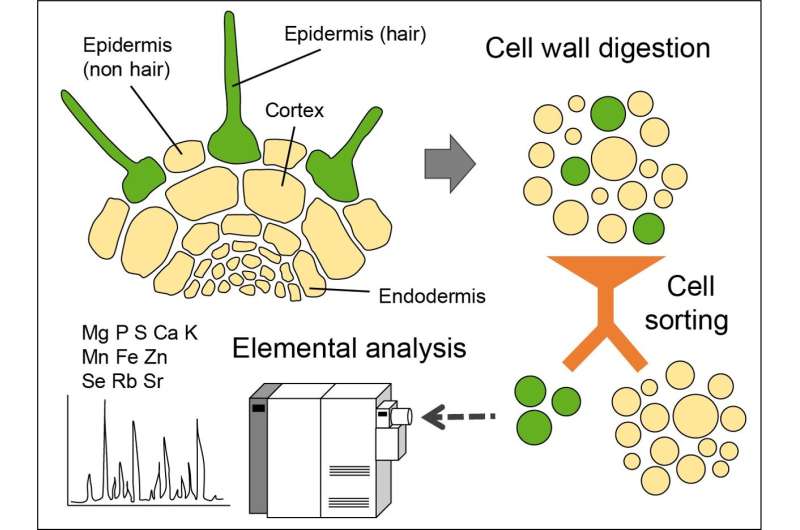This article has been reviewed according to Science X's editorial process and policies. Editors have highlighted the following attributes while ensuring the content's credibility:
fact-checked
peer-reviewed publication
proofread
New approach to investigating element distribution and transport pathways in plants

Plant roots play a critical role in taking up, selecting, enriching and retaining a range of different mineral elements, thereby supplying distant plant tissues with nutrients while sequestering excessive amounts of metals. To execute such element-specific functions, a range of ion transporters present at the roots mediate the uptake, efflux and intracellular compartmentalization of different mineral elements.
Most ion transporters show characteristic tissue and cell type–specific localization patterns, which can be altered in response to internal signaling or external cues. To fully understand the role of the multitude of ion transporters and transport pathways acting in roots, it is necessary to determine their contribution to element distribution in cells and tissues.
The best method for simultaneous quantification of multiple elements is inductively couple plasma mass spectrometry (ICP-MS). However, ICP-MS is still largely restricted to the analysis of whole tissues instead of single tissues or specific cell types. Overcoming this limitation would allow researchers to simultaneously map the distribution of several mineral elements along different root cell layers, a critical step toward fully understanding how roots protect highly sensitive stem cells from toxic elements but share essential and beneficial elements with aboveground parts.
"With this in mind, we developed a method in which distinct cell types isolated from roots of various reporter lines are separated via fluorescence-activated cell sorting prior to elemental analysis with ICP-MS," says Dr. Ricardo Giehl, first author of the new study published in Nature Communications. "Our new method enabled us to determine the concentration of up to 11 mineral elements in different cell types, and to explore the consequences of perturbed xylem loading or altered nutrient availabilities at high spatial resolution."
The researchers used the new FACS-ICP-MS method to reveal significant cell type–specific element distribution and the existence of a steep concentration gradient between outer and inner cell layers in roots. "Furthermore, the cellular concentration ranges for most macro- and micronutrients estimated with our method can serve as reference for future studies," emphasizes Prof. Dr. Nicolaus von Wirén, head of IPK's research department Physiology and Cell Biology.
The method also helped the researchers to identify a cell type–specific enrichment of manganese in roots of plants exposed to iron-limiting conditions. By installing a manganese sequestration mechanism in specific cell types, the researchers uncovered that root hairs play a critical role in retaining the excess manganese taken up by iron-deficient plants, thereby preventing a toxic concentration of manganese build-up in shoots.
"Our results highlight the importance of the particular 'topographical' placement of ion transporters for directing radial movement of ions destined to shoots or for efficient metal sequestration in roots," says Giehl. "The possibility to combine our method with transcriptomics and to develop it further toward single cell ICP-MS offers the possibility to investigate transcriptome-ionome networks at very high spatial resolution. This knowledge is critical to understand and manipulate transport pathways in order to increase nutrient use efficiency while simultaneously preventing accumulation of toxic elements in aboveground tissues."
More information: Ricardo F. H. Giehl et al, Cell type-specific mapping of ion distribution in Arabidopsis thaliana roots, Nature Communications (2023). DOI: 10.1038/s41467-023-38880-0
Journal information: Nature Communications
Provided by Leibniz Institute of Plant Genetics and Crop Plant Research




















